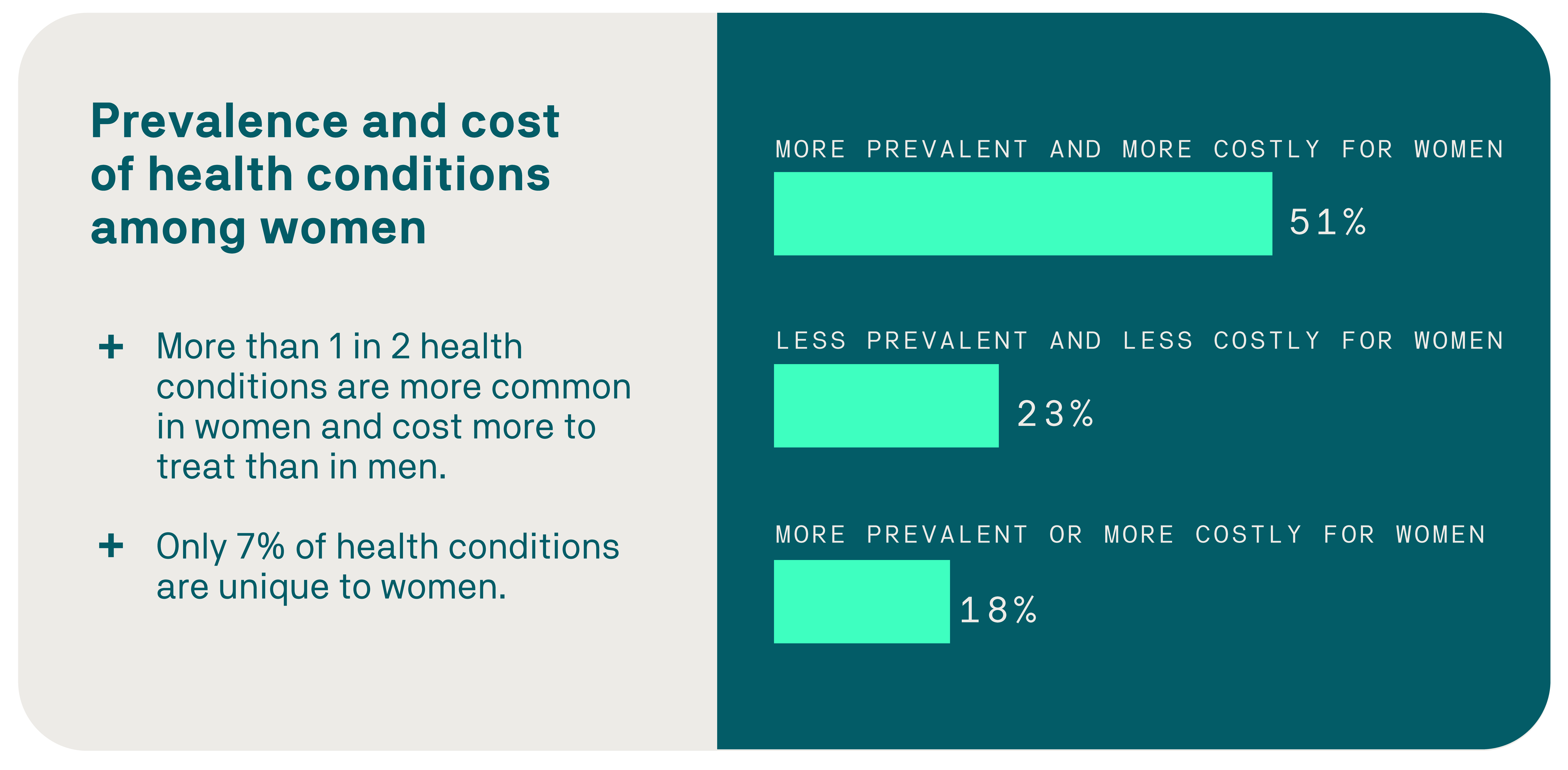Historically, women’s health referred to the narrow category of health issues that are unique to women, such as pregnancy. Today, health care and policy stakeholders are increasingly recognizing that women’s health reaches far beyond obstetrics and gynecology.
An Evernorth analysis of 7.4 million commercially insured people ages 13 to 64 found that while women accounted for 50% of the covered lives, they represented 53% of the patients utilizing health care and 57% of the total costs of care. Furthermore, only 7% of the health conditions evaluated were OB-GYN related (i.e., unique to women), yet 69% of all conditions represented in claims data were either more common or costlier in women, or both. This difference confirms that women’s health extends beyond OB-GYN and the disproportionate burden of disease among women is a call to action for employers, unions, and health plans.
“To truly make an impact in women’s health requires an understanding of how women are affected disproportionately, the drivers of variations in their care, and how they can be better served by health care delivery and benefit design,” said Dr. Calie Santana, medical director for innovation at Evernorth.

Click here to view a larger image. Source: Claims analysis of 7.4M people 13 to 64 years old with commercial insurance (2022 claims year)
Factors that drive variations in care for women
Women’s multifaceted health care needs are underserved for a variety of reasons. Historically, research in women’s health has been underfunded and conditions specific to women have been understudied. Until the start of the Women’s Health Initiative research study in 1991 and passage of the NIH Revitalization Act into law by Congress in 1993, women were not recruited as participants in clinical research to study disease presentations and behaviors specific to women in the U.S. This lack of representation in woman has created a significant gap in knowledge about women, who often have different disease symptoms than men. Medical knowledge and treatments gathered from research limited to male participants are not generalizable to women.
Lack of clinical training addressing certain health conditions and women-specific health issues such as perimenopause and menopause is another reason women’s health care needs aren’t being met. This knowledge gap results in late or incorrect diagnoses and a higher number of unnecessary diagnostic tests. For example, heart disease tends to be diagnosed and treated later in women than in men. The consequences of that lack of recognition of symptoms are sometimes compounded because women are less likely than men to be offered aggressive treatments.
Health equity and social drivers of health are also at the forefront of the issues affecting women’s health care. Average life expectancy for women varies considerably, with factors including race, ethnicity, poverty level, location-related social needs, and education contributing to the differences. Socioeconomically disadvantaged women have higher rates of morbidity, injury, disability, and mortality and tend to have limited access to high-quality health care services. For example, more than 2.2 million women of childbearing age live in maternity care deserts, which are located in 70% of U.S. counties. In addition, maternal mortality rates are increasing, especially among Blacks, Native Americans/Alaskan Natives, and Asian Americans/Pacific Islanders.
Despite notable strides in the U.S. to advance gender equity in the workplace, challenges still exist. Research has found that almost 1 in 4 working women lacked enough time to get the care they needed or were unable to take time off work. Another study showed that 80% of employed women have delayed care until their symptoms worsened or affected their daily lives.
Addressing women’s health issues and reducing disparities
“Underinvestment in women’s health has consequences for plan sponsors and society,” Dr. Santana said. “The under- or over-treatment of women, or mismanagement of conditions in women of specific communities, causes real harm to women, communities, and the economy at large. Women make 8 out of 10 health care decisions in their households, so their health and engagement has a multiplier effect.”
While challenges exist, employers, health plans, hospitals, health care systems, and policy makers can take these steps to improve women’s health care and reduce disparities:
- Include more women across all life stages, social groups, and medical complexities in research and solution design.
- Promote the assessment and dissemination of meaningful outcomes for conditions that affect women disproportionately.
- Enhance research on actionable workplace accommodations for women with certain conditions that include those experiencing perimenopause/menopause.
- Remove barriers to effective, convenient, and affordable whole-person health care solutions that address the specific needs of women and of men.
- Champion technology-enabled tools for early diagnosis and effective treatment of diseases that may present differently in women than in men.
“By focusing on a holistic, patient-centric approach to women’s health and tailored solutions for multiple life stages, we can improve outcomes and extend the significant impact women have within our workforce, our economy, and our society,” said Angela Inneh, director of thought leadership, Evernorth Research Institute.
This article is part of a series by the Evernorth Research Institute that highlights critical issues affecting girls’ and women’s health across different life stages, from adolescence through menopause and beyond. The goal is to educate the general public, health care providers, employers, health plans, policymakers, and advocates about the most pressing concerns in women’s health so that together we can continue to drive meaningful change.
Click here to learn more about this topic in our Women’s Health hub.


